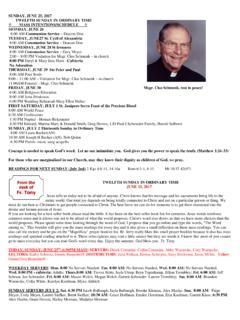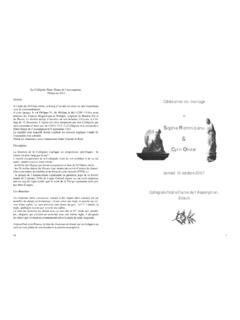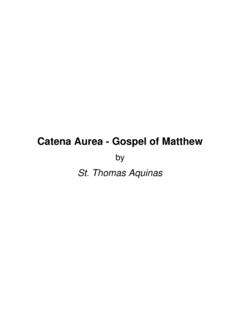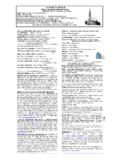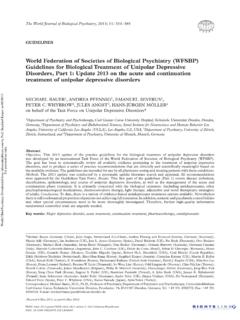Transcription of The Bliss
1 The Bliss CLASSIFICATION BULLETIN. ISSN 0520-2795. No. 52, 2010. IN MEMORIAM JACK MILLS. Contents: Editorial : Jack Mills: recollections, legacy and the way forward Page 1. Jack Mills, 1918 - 2010 : an academic appreciation (Vanda Broughton) Page 3. with Bibliography of published works; Career outline Jack Mills : an appreciation (Jean Aitchison) Page 9. Cat'n'class, 1952 (Tony Curwen) Page 10. BC2, 1997 - 2007 : an overview (Hon. Editor) Page 12. BCA : A statement of intent (Vanda Broughton for the Committee) Page 14. AGM of the Bliss Classification Association 2009 Page 22. Putting Bliss on the Web (Tamara Lopez) Page 16. Statement of Accounts for the year ended 31 July 2009 Page 25. The Bliss Classification Association : Officers & Committee 2010 Page 26.. Editorial : Jack Mills, 1918 - 2010. Recollections, legacy and the way forward IT IS WITH GREAT REGRET that we have to record the death of Jack Mills, chair of the Bliss Classification Association and editor of the Bliss Bibliographic Classification, 2nd edition, on 9th July 2010.
2 College librarian, teacher, information systems researcher and, for us in particular, colleague, friend and inspirational leader in the unending search for better ways of organising recorded knowledge, Jack has left us an impressive legacy and an equally great challenge both to complete the task to which he devoted the greater part of his life and also make it relevant for the twenty-first century. The Classification, however, is not the product of a one-man band, and it is right to pause here briefly to acknowledge, as Jack himself would have done, the contribution made by many others, among them collaborators named in the published volumes, members of the Classification Research Group with whom he shared many hours of debate, and not least his old friend Eric Coates. This issue of the Bulletin therefore falls into three parts. First of all, Jack Mills is seen in retrospect, with appreciations, reminiscences and an assessment of his achieve- ment.
3 He was an outstanding researcher and developer in the field of information retrieval and Vanda Broughton, his former student and later his collaborator and co- editor of BC2 for many years, surveys this aspect of his life. Jean Aitchison pays a warm tribute to his generosity and help especially in relation to her own work in developing thesauri in several subject areas. Finally the Hon. Editor recalls being one of Jack Mills's first students in the 1950s. In the second part, the future of BC2 is considered, with thoughts about not only completing the scheme for existing (and possibly new) users but also involving an increasingly web-oriented community, by making a vast body of material, published, unpublished, and under development, widely accessible. To this end, the Committee is appealing for help and cooperation from all interested people. By way of introduc- tion, there is a list of the BC2 classes for reference, with some editorial comments.
4 The Committee's interim statement of objectives and intent follows. This will be more fully elaborated and debated at the forthcoming Annual General Meeting and after- wards promulgated on the website. Tamara Lopez's paper, Putting Bliss on the Web, speaks of remediation'. Forget any associations with unpleasant remedies and remedial exercises: the terminology here is concerned with media, print and digital, and her paper sets out what will be involved in transforming BC2 to make it available to a wider range of users and collaborators. Finally, the dull formal reports, hitherto found at the beginning of the Bulletin, have been banished to the back pages.. At the end of the career outline appended to Vanda Broughton's appreciation of Jack appears the statement 1985- Retired' One would never have known it. Certainly he was slowing down latterly, suffering from some ill health and in particular distressed by his increasing deafness, but in truth, Jack Mills finally retired on 9th July this year.
5 A. G. C.. The Bliss Classification Bulletin Hon. Editor: Mr A. G. Curwen, Bodnant, Llanbadarn Fawr, Aberystwyth, SY23 3SE. Phone: +44 (0)1970 611861 E-mail: Jack Mills at the Bliss Bibliographic Association meeting Cambridge, 13 September 1995. Photograph: A. G. Curwen]. Jack Mills, 1918-2010: an academic appreciation JACK MILLS SPENT MORE THAN SIXTY YEARS of his life in the study, teaching, development and promotion of classification and information retrieval, principally as a major figure in the British school of facet analysis which builds on the tradition of S. R. Ranganathan. He was a signatory to the seminal paper A faceted classification as the basis of all information retrieval , and represents a significant link in the tradition which begins with Ranganathan and H. E. Bliss , and is represented today in research looking for solutions to the semantic web. The Bliss Classification Bulletin, No. 52, 2010<>. His work as a teacher dates back to 1952, and to his appointment as lecturer at the newly formed North Western Polytechnic School of Librarianship.
6 He taught at the University of Maryland from 1966/67, helping to set up the Library School there, and, after returning to London, taught on short courses, and as a visiting lecturer around the world. He is remembered by generations of students as an inspirational lecturer, and one who made cataloguing and classification (too often regarded as dull) a fascin- ating subject. His 1960 publication Modern outline of library classification was the standard textbook for British librarianship students for many years, and translated into several languages. But he is probably best known to the wider professional community as a scholar and researcher. His interest in classification, his teaching experience, and his early public- ations, led to an invitation to join the Classification Research Group (CRG), which was formed in 1952 as a result of the 1948 Royal Society Conference on Scientific Information. He was a speaker at the first International Study Conference on Classi- fication for Information Retrieval at Dorking in 1957, and the keynote speaker at the sixth conference at University College London, forty years later.
7 In 1963/64 he was seconded to be Deputy Director of the Cranfield Project, suppor- ting Cyril Cleverdon in the first major exercise in information retrieval in the United Kingdom. The results of the work at Cranfield had a major influence on British information science, and the documentation from that project continues to be cited in the professional literature today. He was a passionate advocate for classification theory, and also lectured and wrote about the Bliss Bibliographic Classification, the Universal Decimal Classification, and, most recently, the second edition of Bliss which embodies the whole corpus of information retrieval theory developed by the CRG since the 1950s. When the Library School at the Polytechnic of North London opened in 1968, Jack was the initial choice as head of department, an offer he declined, as he wanted to concentrate on research. He moulded the research department at PNL into one of the most successful UK LIS research groups ever, presiding over such important work as the Intermediate Lexicon, DISISS, the Hillingdon Project, and several classification projects including the creation of schemes for the Royal National Institute for the Deaf, the Wessex Regional Health Authority, and the Library Association.
8 From the 1960s he was the driving force behind the revision of the Bliss Bibliogra- phic Classification, chairing the Bliss Classification Association Committee, and undertaking the greater part of the work of revision as Editor of the new scheme. A. great admirer of Bliss 's classification, Jack had installed it in the library of the City of London College, a project which brought him into correspondence with H. E. Bliss , and occasioned several publications. While preserving the general structure of the original, the revised edition of the classification (BC2) is to all intents and purposes a new scheme of classification, realising the hopes of the CRG for the development of a new British scheme of classification, which had failed to come to fruition through the work financed by the NATO grant in the 1950s. Although relatively little has been written about BC2, its impact on the field of knowledge organization and retrieval has been immense.
9 The influence of the published volumes of BC2 can be seen in the recent revisions of many other systems of classification, notably the Dewey Decimal 4. The Bliss Classification Bulletin, No. 52, 2010<>. Classification and the Universal Decimal Classification, whose editions since the 1970s incorporate many features of the fully faceted classification. Facet analysis is not only relevant to traditional classification and knowledge organization systems. The methodology supports the generation of thesauri and subject heading lists, and the creation of structured vocabularies for metadata. Several faceted thesauri were derived from BC2 classes, notable examples being Jean Aitchison's work on the Department of Health Thesaurus, and that at the Royal Institute of International Affairs, built respectively on Classes H and R of the classification. Today facet analytical techniques are to been seen embedded in much commercial retrieval software, in search engines on commercial sites, and in very many research projects both in academic institutions and professional organizations.
10 In 1998 Jack Mills was acknowledged by the Conference on the History and Heritage of Science Information as a pioneer of information science', and was among twenty nominees invited to a dinner in their honour at the Conference in Pittsburgh. In 2003. his contribution to the field was marked by the award of an Honorary Fellowship from the Chartered Institute of Library and Information Professionals (CILIP), and in 2005. he received the Tony Kent Strix award for his contribution to information retrieval. In a long career, Jack published relatively little by current standards, as did most of his contemporaries in the CRG. But the quality of that small corpus of work is considerable, and in his late eighties he was still making a significant contribution to the scholarly literature. And although BC2 may be perceived primarily as a practical tool, rather than a conceptual work, the statement of principles in the Introduction to the scheme is almost alone in documenting the corporate theory of the CRG as it developed from 1950 and throughout the twentieth century, and is one of the few coherent statements of modern classification theory.
